
I have always liked strategy games. It’s been a long time since I played a game of chess though. It really amazes me that grandmasters can see 15 to 20 moves ahead if given enough time. When it comes to living our lives though, and planning our ministry, we often live by default. We let life happen to us rather than identifying our passion, establishing a focus and stepping out with initiative as we move into the future. The same goes for our leadership. Are we simply responding to the issues arising in our environment and team or are we praying into the future with strategic thinking to see how we can best impact our world?
I am going to be sharing 7 strategic tools that can all fit together helping you go from your initial dream to the detail of implementation. If you are a visionary, don’t be overwhelmed by the charts, you probably need an operational or analytical leader to come alongside you. We need visionary and management gifts in pioneering and development of ministry. You can pick and choose what tool will help you in your present situation.
1. Identifying your Passion: Two months ago, I wrote an article about identifying your element, your passion, the thing that gets you out of bed every morning. This for me, is always the starting point of strategy. We need to see the big picture out there. What are we heading for? With passion in our heart there will be a drive to see something happen. Perhaps you have a vision for a training campus, or if you are located in the city you are focused on specific ministries to reach out and bless the city, or perhaps it’s both where you are training up people for those specific ministries. Write down your vision with a succinct sentence with a focus and result you are looking for. Here is my example.

| My/our Passion: The spirit of the Lord has anointed me/us to…. |
2. A Base Audit: If you are involved in a YWAM community, team, or base, you were formed and established from a foundational vision. It’s good to know your history and the ministry that first inspired the pioneering of the team. For example, the city ministry we formed in Paisley, started with a drop in café for young people and developed into a rehab, a church based DTS, a ministers’ fraternal, a preschool, kings kids and a university ministry. Then the courses began with training of Operation year (a one-year DTS), a principles of early childhood education, Principles of child and youth ministry and a school of urban missions.
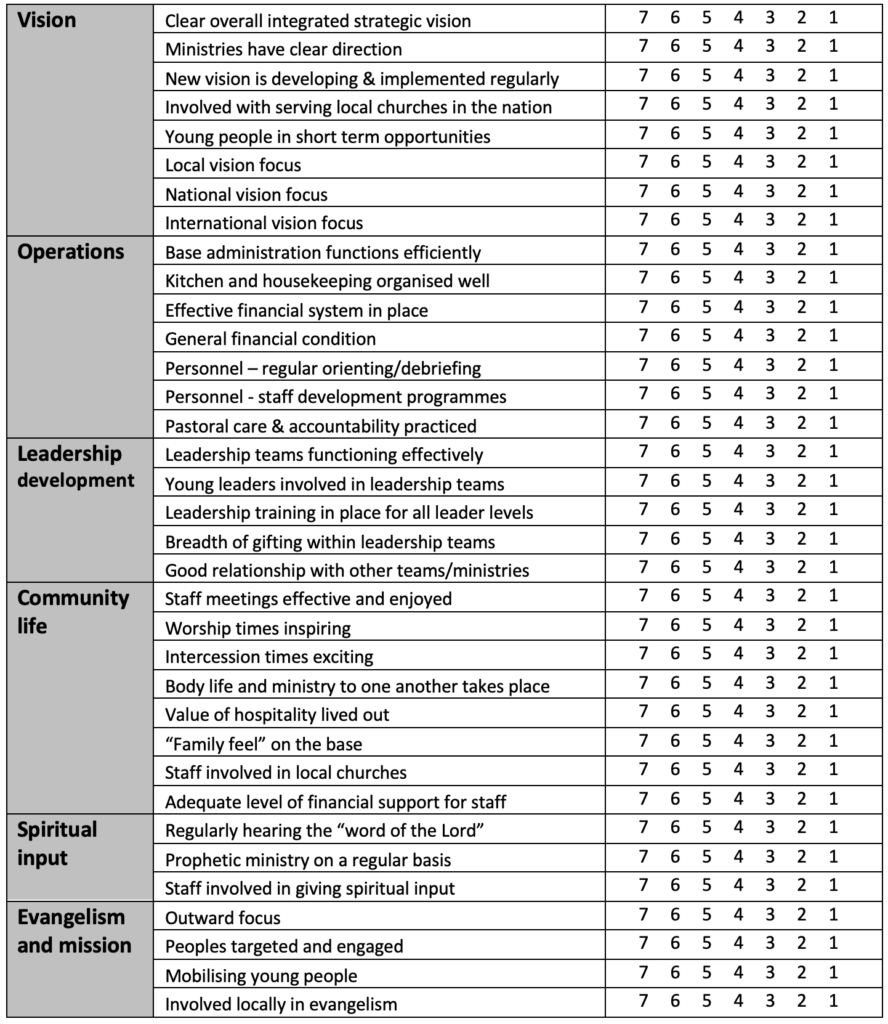
All that happened over a period of 6 years. Now, that may have been some time ago and so it is helpful to have an audit of where you are as a community now. The following chart lists out some of the categories of our community life and asks you to rate each category by circling the number from 1 to 7. 1 being low and 7 being high. From the chart above you can easily see your strengths and weaknesses. You can list them below.

3. The SWOT analysis:
This is a well-known simple tool to help give us the big picture of where we are at right now.
This tool can add more specifics having been through the audit above. In a leadership group, divide up into small groups and supply people with a stack of post-it-notes. You can give a different colour to different groups if you want to follow up with the team when the exercise is complete.
Take each of the categories one by one (Strengths – Weaknesses – Opportunities – Threats) and work on them as a group brainstorming your answers and placing them on post it notes. These can be posted on a large board divided into the 4 categories.
When the process is complete, then everyone can read one another’s input and some good word smithing will help to bring down the content down to a readable document.
Then comes the task of drawing out from the exercise what we can learn and the action steps we need to take.
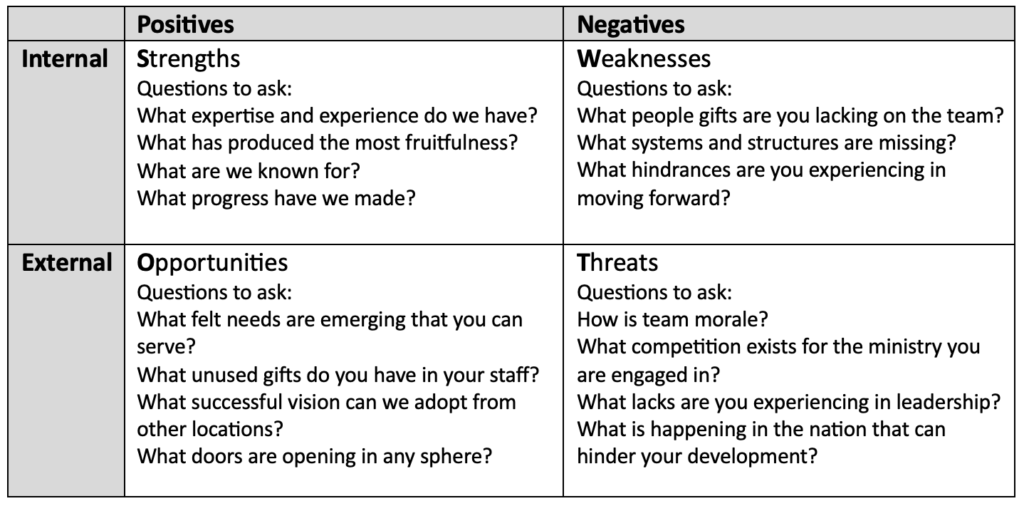
4. Analysis, vision and process chart: Now that we have a good idea of our present situation, we can be very honest and practical with how to move forward. Here are some more questions to be processed as a team or ministry group with the development of some clear steps and goals for the future. This can be used on a yearly basis for a team to help them reflect on the previous year and set goals for the coming year.
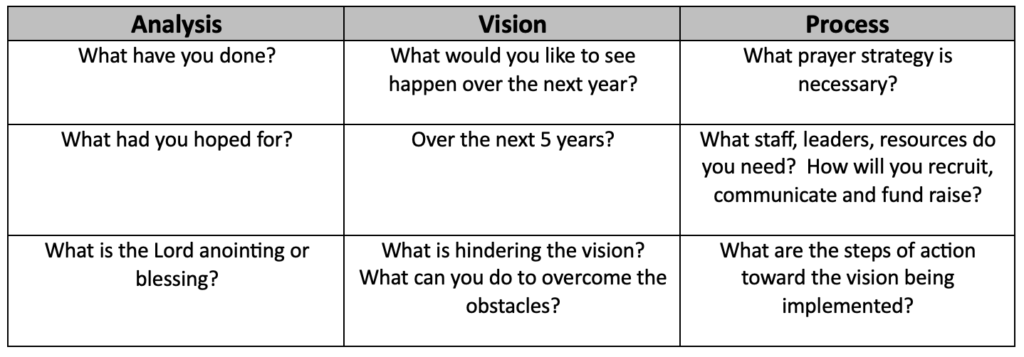
5. Back to our vision, strategies, and target
statements: There are 3 steps to seeing your vision implemented.
a. Vision: Write out your vision, your passion, your purpose or whatever you
want to call your big picture in a concise statement. Sadly, some processes stop there, and your
statement will find itself in a file drawer somewhere.
b. Strategies: Now take your vision statement and think of the strategies or the ministries you want to develop to fulfil that vision. These will change and adapt over time and often more ministries will be added or updated.
c. Targets: Now we can get more specific with goals that we want to see accomplished with each strategy or ministry. You can decide on the time frame of a year, 2 or 3 or 5 years ahead. You will end up with a plan of what you want to see happen and how you want to see it happen.
Here is a personal example of how it can look:
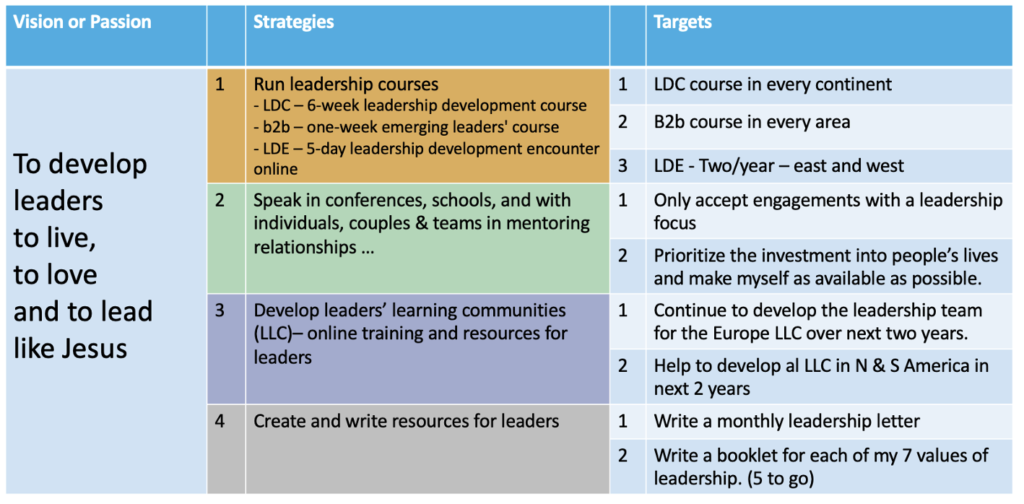
The next stage involves an activity plan. This is where you have a specific project in mind as one of your targets and it gives the opportunity of brainstorming the ‘to do’ items, scheduling them and determining who is going to do what, in what time frame.
6. Activity
Planner: When it comes time to start the
ministry, schedule an event, or run a training program, this planner comes in
handy.
First of all, brainstorm the activities and then place them in order of
implementation on the activity plan.
Example of the kind of activities to include:
- Schedule leadership team meetings/reviews
- Communicating through advertising
- Presentation of the vision to staff, churches, social media, ….
- Fund raising plan and implementation.
- Recruiting and Forming team – volunteers, locals, staff
- Identifying locations to work
- Identify starting dates.
- Hospitality
- Set up accommodation.
- Writing and sending reports, newsletters, updates
- Staff training
Here is an example of the activity plan for the leadership development encounter online course that I run each year.
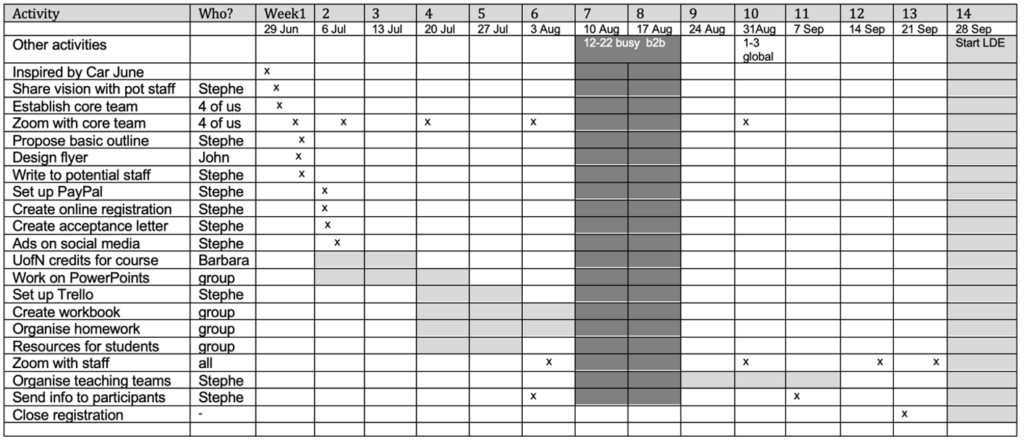
7. Project plan: There are many apps to help the process of planning but the one I have found most helpful is called Trello. This app allows you to add all your team members to view and edit the content. The Trello board can contain all the information that all your team will need for the project or training program that you are organising.
You can make lists of everything you need to do. The first three lists can be – things to do, things in process and things done. Each card in the list can have the information and the person or people responsible for the action.
I have used this app for every training program that I have developed. It contains the staff, students, schedules, handbooks, powerpoints, videos, etc…. Every card in each list is interactive. It has been so helpful and I fully recommend it for those of you who have a desire to be more organised.
Here is an example of part of the leadership development online (LDE) Trello board.
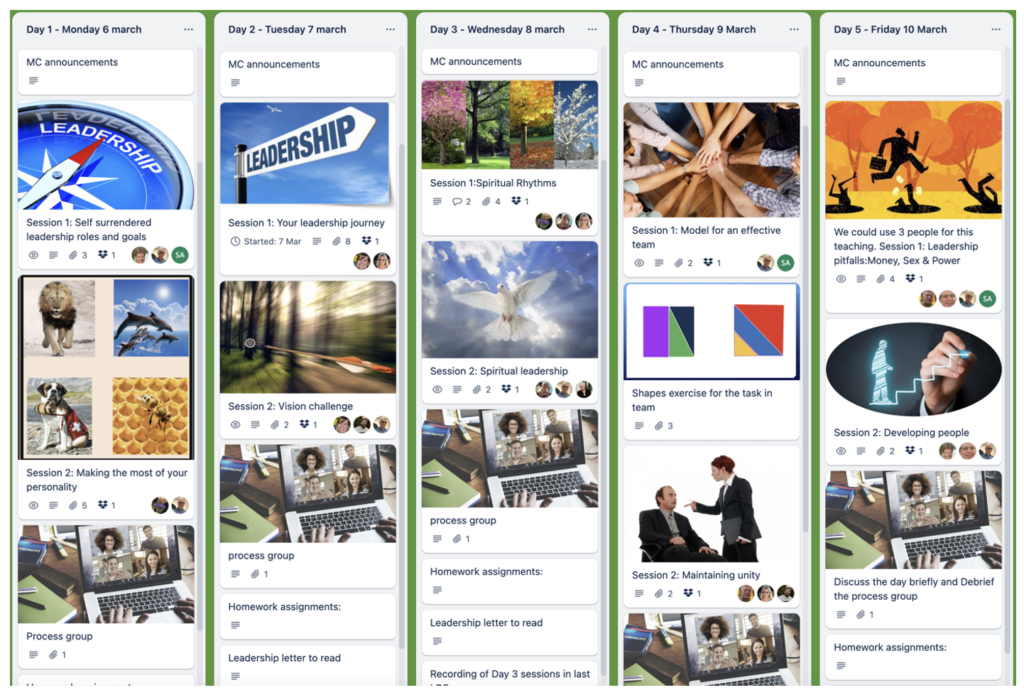
Hoping you will take the challenge of becoming more strategic in your leadership.
Until next month
Stephe
